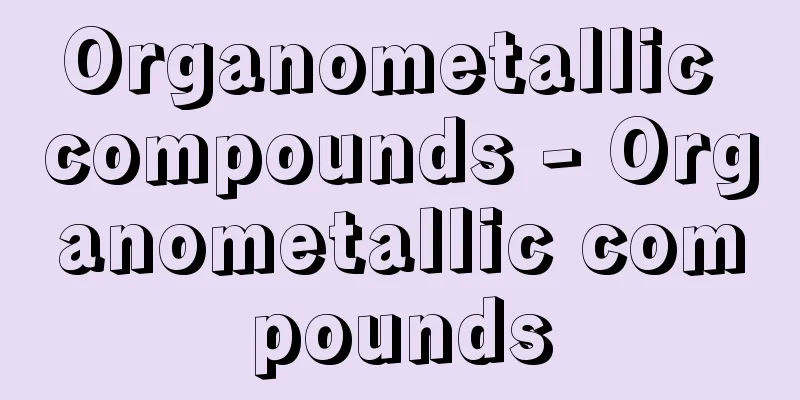Organometallic compounds - Organometallic compounds

|
A general term for organic compounds that have a direct carbon-metal bond. It can also include complexes that do not have a carbon-metal bond but have a hydrogen-metal bond (called hydride complexes). Organic compounds in which the oxygen, nitrogen, or phosphorus atoms are bonded to metals are not included. These are carboxylates or alkoxides, and metal complexes with ethylenediamine or triphenylphosphine as ligands are also not included in organometallic compounds. Here, metal atoms refer to the typical elements and transition metal elements shown in light blue on the periodic table. It also generally includes the elements with little metallic properties (also called semimetals, semimetals, or metalloids) shown in light red. In many cases, organometallic compounds are unstable and will ignite or decompose on contact with water or air. Carbon-metal bonds are also highly reactive, and carbon dioxide, carbon monoxide, olefins, dienes, acetylene, oxygen, hydrogen, and other elements can be inserted between these bonds, making some compounds highly useful industrially as intermediates or catalysts in organic synthesis. For example, one type of magnesium compound plays an important role as a Grignard reagent, and triethylaluminum, an aluminum compound, plays an important role as a Ziegler catalyst. In addition, organic compounds containing metals are often used as medicines and pesticides, but they must be handled with great care, as there have been cases of poisoning believed to be caused by metal compounds. [Kozaburo Nishiyama] SynthesisBecause there are so many metal elements, there are a wide variety of synthesis methods, especially for transition metal compounds. Representative examples of synthesis methods are shown below. (1) Direct method: Reaction of a metal with an organic halogen compound. M+RX → RMX (2) Indirect method: A reaction between an organometallic compound synthesized by a different, easier method and a metal or metal halide. MR+M′→M′R+M (3) Reaction of metal-hydrogen or metal-carbon bonds with unsaturated bonds (addition reactions).
(4) Reaction of an organic compound containing active hydrogen with a metal or metal halide (substitution reaction). M+ nRH → MRn [Kozaburo Nishiyama] Structure and propertiesIt is important to know the structure and properties of organometallic compounds in order to utilize them. The properties of the metal-carbon bond vary depending on the ligand and the type of metal. The structures and properties also differ between compounds of typical metal elements and compounds of transition metal elements. Below, they are classified according to their bonding style. [Kozaburo Nishiyama] Main group metal element compoundsThese compounds are roughly divided into those with covalent bonds and those with ionic bonds, and the electronegativity of the metal is a useful rough guide, but the bonding state can also change depending on the properties of the organic group. Here, we distinguish between multi-center types with covalent bonds and classify them into three types. (1) Ionic bond The bond formed with electrically positive alkali metals is ionic. Therefore, organometallic compounds of alkali metals are insoluble in hydrocarbon solvents and highly reactive to oxygen and water. For example, the sodium salt of cyclopentadiene is one such compound. (2) Covalent bonds Elements on the right side of the periodic table have relatively high electronegativity and tend to exhibit properties similar to organic compounds. For example, they tend to dissolve in many organic solvents and exhibit considerable volatility. Metals in groups 13 to 16 are included in this category. For example, they are known as organosilicon compounds. (3) Multicenter Bonds Compounds of some metals, such as Li, Be, Mg, B, and Al, are often present as associations because of their low stability as monomers. In this case, the alkyl groups or hydrogen of the ligands act as bridges. Diborane is an example of this. [Kozaburo Nishiyama] Transition metal compoundsThe structures of these compounds vary depending on the number of metals and ligands used, but they can be roughly classified into those that form σ (sigma) bonds and those that form π (pi) bonds. (1) σ-bonds Many transition metal compounds with σ-bonds are unstable, but some can be made relatively stable by adding stabilizing ligands such as carbon monoxide or tertiary phosphines. For example, Ti(CH 3 ) 4 decomposes at -50°C, but Ti(CH 3 ) 4 (bipy) 2 with bipyridyl added does not decompose even at 0°C. (2) π bond Many transition metal elements form relatively stable π complexes. In this case, various π complexes are formed depending on the number of π electrons of the ligand and the type of metal. For example, olefin π complexes, π allyl complexes, cyclopentadienyl complexes, η (eta) arene complexes, etc. In the notation of π complexes, η indicates the number of carbon atoms involved in the bond. [Kozaburo Nishiyama] ApplicationsMany of these compounds are important reagents for organic synthesis, such as reduction with alkyllithium, Grignard reagents, and tin hydride compounds. Many transition metal complexes are also widely used as catalysts for selective synthesis under mild conditions. Lead compounds were used as anti-knock agents for gasoline, but are no longer used for this purpose due to pollution issues. Silicon compounds have a wide range of uses as silicones. Many other organometallic (including boron, tin, ferrocene, etc.) polymers have been researched and used as heat-resistant polymers. Tin compounds are also used as stabilizers for chlorine-containing polymers (such as polyvinyl chloride). Meanwhile, various organometallic compounds are used as fungicides and insecticides, mainly mercury, arsenic, and tin compounds, but some are prohibited from being manufactured due to their effects on the human body. There are also many examples of metal compounds being used for medical purposes. For example, taking advantage of the property of boron being easily concentrated in cancer tissue, a treatment is being carried out in which boron-10 (natural boron contains about 18% boron-10) decays through neutron irradiation to produce alpha particles that destroy cancer tissue. [Kozaburo Nishiyama] [References] | | | | | |©Shogakukan "> Metal elements (periodic table) ©Shogakukan "> Diborane (BH) structure ©Shogakukan "> Examples of pi bonds in transition metal elements Source: Shogakukan Encyclopedia Nipponica About Encyclopedia Nipponica Information | Legend |
|
有機化合物のなかで炭素‐金属原子の直接結合をもつものの総称。また、炭素‐金属結合をもたないが水素‐金属結合をもつ錯体(ヒドリド錯体という)を含めることもある。有機化合物中の酸素、窒素、リン原子が金属に結合している場合は含めない。これらはカルボン酸塩やアルコキシドであり、また、エチレンジアミンやトリフェニルホスフィンなどを配位子とする金属錯体も有機金属化合物には含めない。ここで金属原子とは周期表の薄青色で示した典型元素と遷移金属元素をいう。また、一般には薄赤色で示した金属性の少ない元素(半金属、セミメタル、あるいはメタロイドともよばれる)を含める。 多くの場合、有機金属化合物は不安定であり、水や空気との接触で発火したり分解する。また、炭素‐金属結合は反応性に富んでおり、この結合の間に炭酸ガス、一酸化炭素、オレフィン、ジエン、アセチレン、酸素、水素などが挿入されるので、有機合成の中間体や触媒として工業的にも利用価値の高いものがある。たとえば、マグネシウム化合物の一種はグリニャール試薬として、また、アルミニウム化合物の一つであるトリエチルアルミニウムはツィーグラー触媒として重要な役割を果たしている。そのほか、金属を含む有機化合物が医薬や農薬として用いられている例も少なくないが、金属化合物が原因と思われる中毒問題が話題になったこともあり、取扱いは十分注意する必要がある。 [西山幸三郎] 合成法金属元素の数が多いことからもその合成法は非常に多岐にわたっており、とくに遷移金属化合物の合成法は多様である。次に合成法の代表例を示す。 (1)直接法 金属と有機ハロゲン化合物の反応。 M+RX→RMX (2)間接法 別の合成しやすい方法で合成した有機金属化合物と、金属あるいは金属ハロゲン化物との反応。 MR+M′→M′R+M (3)金属‐水素あるいは金属‐炭素結合と不飽和結合の反応(付加反応)。
(4)活性水素をもつ有機化合物と、金属あるいは金属ハロゲン化物の反応(置換反応)。 M+nRH→MRn [西山幸三郎] 構造と性質有機金属化合物の構造と性質を知ることは、それを活用するためにも重要である。金属‐炭素結合の性質は配位子や金属の種類によって異なる。また、典型金属元素化合物と遷移金属元素化合物とでもその構造と性質は異なる。以下、各結合様式により分類した。 [西山幸三郎] 典型金属元素化合物これらの化合物は、共有結合とイオン結合を有するものに大別されるが、その大まかな目安としては、金属の電気陰性度が役だつが、有機基の性質によっても結合状態の変わることもある。ここでは共有結合を有する多中心型を区別して3種類に分類した。 (1)イオン結合 電気的に陽性なアルカリ金属とつくる結合はイオン的である。したがって、アルカリ金属の有機金属化合物は炭化水素溶媒には不溶で、酸素や水に対してきわめて反応性が高い。たとえば、シクロペンタジエンのナトリウム塩などがそうである。 (2)共有結合 周期表の右のほうにある元素は電気陰性度も比較的高く、有機化合物的な性質を示すようになる。たとえば、多くの有機溶媒に溶け、かなりの揮発性を示すようになる。13~16族の金属はこれに含まれる。たとえば有機ケイ素化合物などである。 (3)多中心結合 Li、Be、Mg、B、Alなどいくつかの金属の化合物は、単量体としての安定度が低いため、多くの場合会合体として存在する。この場合は、配位子のアルキル基や水素が、橋かけの役割を果たす。たとえば、ジボランなどがその例である。 [西山幸三郎] 遷移金属元素化合物これらの化合物の構造は、その金属の種類の多さや配位子によって多様である。しかし、大まかにはσ(シグマ)結合を形成しているものと、π(パイ)結合を形成しているものに分類される。 (1)σ結合 σ結合をもつ遷移金属化合物は不安定なものが多いが、一酸化炭素や三級ホスフィンなどの安定化配位子を用いると比較的安定になるものもある。たとえばTi(CH3)4はマイナス50℃で分解するが、ビピリジルを加えたTi(CH3)4(bipy)2は0℃まで分解しない。 (2)π結合 多くの遷移金属元素は比較的安定なπ錯体を形成する。この場合、配位子のπ電子の数や金属の種類によりいろいろなπ錯体をつくる。たとえば、オレフィンπ錯体、πアリル錯体、シクロペンタジエニル錯体、η(エータ)アレーン錯体などである。π錯体の表示法でηは結合に関与している炭素数を示す。 [西山幸三郎] 用途アルキルリチウムやグリニャール試薬、水素化スズ化合物による還元など、有機合成にとって重要な試剤が多い。また、遷移金属錯体の多くは穏和な条件下での選択的合成の触媒として広く用いられている。鉛化合物はガソリンのアンチノック剤として使用されていたが、現在は公害問題などのため、この用途では用いられない。ケイ素化合物はシリコーンとして用途は広い。それ以外でも多くの有機金属(ホウ素、スズ、フェロセンなどを含む)ポリマーが耐熱性ポリマーとして研究、使用されている。含塩素ポリマー(ポリ塩化ビニルなど)の安定剤として、スズ化合物が用いられている例もある。 一方、殺菌剤、殺虫剤としていろいろな有機金属化合物が利用されており、水銀、ヒ素、スズ化合物などがそのおもなものであるが、人体への影響などから製造を禁止されているものもある。医療用として金属化合物が用いられている例も多い。たとえば、ホウ素ががん組織へ濃縮されやすいという性質を応用して、中性子照射によりホウ素10(天然のホウ素は約18%のホウ素10を含有)が崩壊しα(アルファ)粒子でがん組織を壊す治療法も行われている。 [西山幸三郎] [参照項目] | | | | | |©Shogakukan"> 金属元素(周期表) ©Shogakukan"> ジボラン(BH)の構造 ©Shogakukan"> 遷移金属元素のπ結合の例 出典 小学館 日本大百科全書(ニッポニカ)日本大百科全書(ニッポニカ)について 情報 | 凡例 |
<<: Yuki Family Law - Yukike Hatto
>>: Organometallic chemistry - Organometallic chemistry
Recommend
Radiation biology
This is a science that seeks to elucidate the phe...
Reply
〘noun〙① A receipt. A receipt. In the Nara and Heia...
Sinobronchial Syndrome
[What kind of disease is it?] If you have sinusiti...
Oracle
American software manufacturer founded in 1977. Kn...
Mr. Cho - Chouji
A Noto no Tono samurai family of the Middle Ages a...
Freedom of belief - Jiyuushinshoshugi
It is a principle that leaves the probative value...
Atwood, T.
…In June 1936, the London Working Men's Assoc...
Mauretania Caesarensis (English spelling)
…In the process, it became a Roman protected king...
Athenian Second Maritime League - Athenian Second Maritime League
A league that Athens called on other cities to est...
Gakashi paper
… Paper that has been made as is is called “raw p...
Keicho Kenmonshu - The Keicho Era
A record of the observations made in the early Edo...
Achromycin - Achromycin
A brand name for the antibiotic tetracycline. Sour...
Right heart catheterization - Ushinkatteteruho
… The first person to perform cardiac catheteriza...
Estigarribia, JF - Estigarribia
...World War I brought a lull, but in 1932 a bord...
Katsushika Shofu
...A school of haiku poetry. It is also called Ka...









